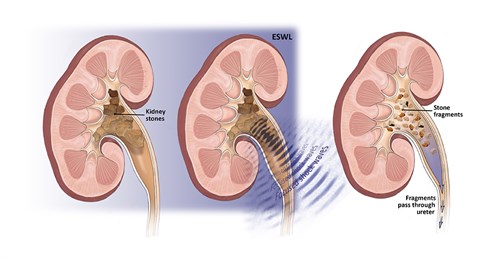Shock Wave Lithotripsy (SWL)
Shock wave lithotripsy is a non-invasive option for people with smaller stones that are too large to pass on their own. There are no incisions and no scopes placed into the patient's body. SWL, however, may not be appropriate for all patients as the shock waves may not adequately break up certain stones. Stones smaller than 2 cm in diameter are typically the best size for SWL treatment. SWL is usually not appropriate for cysteine stones as these stones are more difficult to break up with the shock waves.
SWL is not indicated for very large stones and is also dependent on the size, exact location of the stone within the kidney and the type of stone that has formed. A urologist will be able to determine if you are an appropriate candidate for this non-invasive procedure.

How Shock Wave Lithotripsy Works
X-ray is utilized to locate the stone(s) within the kidney. High energy shock waves are then delivered through the body to the stone. These shock waves break up the stone(s) into very small particles that can then be passed through the urinary system.
SWL is an outpatient procedure and typically takes about one hour to perform. You may receive local anesthesia or a sedative for your comfort during the procedure. In some cases where the stone is blocking the ureter, you may have a stent placed to open up the urinary tract to allow for the stone fragments and urine to pass through following SWL. Your urologist will determine if a stent is necessary after viewing the X-ray images.
After the procedure, you will be monitored for about an hour before going home as long as no complications are present. Drinking plenty of fluids will help you pass the small stone fragments. Your urologist may ask that you strain your urine to capture passed stone pieces for analysis. This analysis is important for an overall treatment plan that will help keep you stone free for the future. You may also be prescribed certain medications for pain as you pass the stone fragments, and antibiotics to prevent infection.
